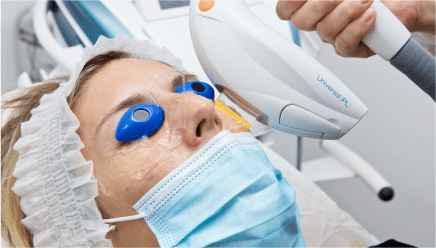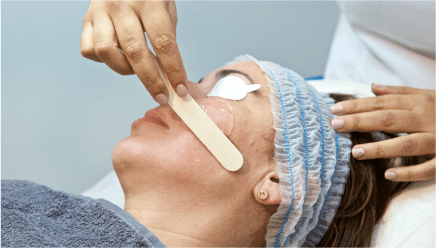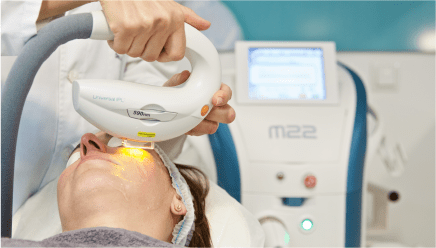Dry eye / Dry Eye: Pulsed Light Treatment
Pulsed light treatment (IPL) for dry eye: what does it involve?
Pulsed light is an innovative treatment for dry eye that, depending on the severity of the condition, can provide relief from the very first session. It is a revolution in the field of ophthalmology as until now the only treatments available to reduce the symptoms of this uncomfortable condition were medication, massage or the application of heat. But thanks to pulsed light treatment, we can now treat dry eye directly and reduce the symptoms with more long-lasting results.
Our ophthalmology centres are some of the few clinics that use these pulsed light systems, as not many of them are available yet for advanced treatment of dry eye. This technology also helps the ophthalmologist to treat patients for other eye disorders, such as blepharitis (inflammation of the eyelids) and chalazions.

Pulsed light treatment for dry eye
Once the ophthalmologist has performed the necessary diagnostic tests to determine whether the patient is a viable candidate, they will carry out the treatment. This involves 4 to 6 sessions (depending on the patient’s age and the severity of the condition), with an interval of two weeks between each session. It is usually recommended that the treatment be repeated once a year.
Each session takes around 5 to 10 minutes and is totally painless and straightforward, with no need for surgery.
Below we will explain the benefits of the pulsed light technology that we use at Oftalvist:
This advanced technology produces high-intensity polychromatic light, and also includes a system that naturally cools the skin during the treatment, to prevent any harmful secondary effects.
It can be safely used on any skin type. Furthermore, our intense pulsed light system is highly versatile, as not only does it treat dry eye, but it can also be used to treat skin disorders such as rosacea, telangiectasias and blemishes.
Advantages of the treatment
• Reduces local inflammation and bags under the eyes.
• Improves circulation in the area.
• Removes abnormal veins surrounding the meibomian gland (telangiectasias).
• Also helps oils to be secreted by the meibomian glands, while also improving stability of the tear film and helping to stabilise conjunctival and eyelid flora thanks to its antimicrobial and antiparasitic properties, which is why it is recommended for treating blepharitis and Demodex.

How does IPL work?
The technology emits intense pulses of light that penetrate the tissue until they reach the meibomian glands. The objective is to not only relieve the symptoms, but also treat the cause. To do this we expand the glands so we can treat them effectively. In doing this, we eliminate any abnormal blood vessels and cure the inflammation in both the skin and the eyelids, thus improving the appearance of the area around the eyes and the rest of the face.
After the procedure, the patient may experience some redness around the treated area, but this should disappear a few hours after the session.

Blepharitis treatment with IPL
Thanks to its anti-inflammatory, antimicrobial and antiparasitic properties, pulsed light is also suitable for treating patients with blepharitis, who suffer from meibomian gland dysfunction, irritation and, often, demodex mite infection.
If a patient suffers from chronic blepharitis, they may even suffer eyelash loss or poor vision if preventive measures are not taken or the right type of treatment is not prescribed.
The main goal is to improve quality of life for these patients thanks to the benefits of this therapy, and also by reducing their dependence on other treatments, such as artificial tears.
Chalazion treatment with IPL
This is one of the least invasive techniques. It involves using exfoliation to remove the membrane that covers the meibomian glands. A massage is then performed to drain the contents of the glands, applying a cold compress and antioxidants to reduce the inflammation of the eyelids and improve lymphatic drainage.
Should I follow any particular medical guidelines at home after the treatment?
→ Avoid exposure to sunlight for 7 days following the treatment.
→ Protect the treated area with SPF 50 sun cream.
→ Clean the treated area with pH neutral soap, without rubbing or using hot water.
→ During the treatment, we recommend avoiding any medications that cause photosensitivity and vitamin supplements that increase tanning.
→ Do not stop your usual ophthalmology treatment unless the specialist advises you to do so.
Frequently asked questions
→ Does dry eye only occur in one eye?
No, in fact it is common to suffer from dry eye in both eyes. However, it is possible to suffer from asymmetrical dry eye, meaning you have discomfort in one eye but not the other.
→ What kind of contact lenses should I use if I have dry eye?
→ Can dry eye be cured?



